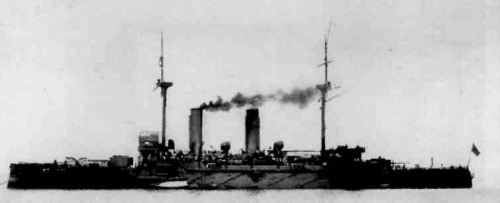

Asama 1899
| Name | No | Yard No | Builder | Laid down | Launched | Comp | Fate |
| 浅間 [Asama] | 661 | Armstrong, Elswick, UK | 11/1896 | 22.3.1898 | 18.3.1899 | TS 1937, surrendered 8.1945, BU 1947 | |
| 常磐 [Tokiwa] | 662 | Armstrong, Elswick, UK | 1/1898 | 6.7.1898 | 18.5.1899 | minelayer 4.1922, sunk 9.8.1945 |
|
Displacement normal, t |
9700 |
|
Displacement full, t |
10500 |
|
Length, m |
124.4 pp 134.7 oa |
|
Breadth, m |
20.5 |
|
Draught, m |
7.43 |
|
No of shafts |
2 |
|
Machinery |
2 VTE, 12 single-side cylindrical boilers |
|
Power, h. p. |
18000 |
|
Max speed, kts |
21.5 |
|
Fuel, t |
coal 1406 |
| Endurance, nm(kts) | 10000(10) |
|
Armour, mm |
Harvey nickel steel - belt: 178 - 89, bulkheads: 152, upper belt: 127, barbettes: 152, turrets: 152, casemates: 152, deck: 76-51, CT: 356 sides, 76 roof |
|
Armament |
2 x 2 - 203/45 Armstrong U, 14 x 1 - 152/40 Armstrong Z, 12 x 1 - 76/40 Armstrong N, 7 x 1 - 47/30 21/2pdr Hotchkiss Mk I, 5 - 450 TT (1 bow, 4 beam) |
|
Complement |
726 |
Project history: Ordered under the 1896 Second Naval Expansion Programme and built to a design prepared by Sir Philip Watts. The design was an improved version of the Chilean O'Higgins, with increased protection and a more powerful armament in better sited positions. A total of 163 watertight compartments were provided, 32 of them in the double bottom.
On trials both ships exceeded their designed speed by about 1.5 kts and proved to be economical steamers. Performance deteriorated mainly because of poor maintenance, and by 1904 the speed of the Asama had dropped to 19 kts.
Since 1922 Tokiwa was used for mine storage. In 1928-1929 according to the 1923 program she was converted to minelayer. Aft main turret and 152mm guns from lower deck were removed. On 2nd (mine) deck mine rails were mounted, and for their conclusion big ports are cut in the stern. In 1940 ship was rearmed: last main turret and 152mm guns, except four, were removed. After conversion real speed did not exceed 16kts, in comparison with 21.3kts on commissioning trials in 1899.
Ship protection: Main 178mm belt had 86.6m length (between barbettes) and 2.1m height, closed by 152mm bulkheads abreast barbettes. Its thickness was 89mm outside barbettes. Upper 127mm belt had dimensions 65.2x2.1m. 51mm deck was connected with lower edge of main belt by 76mm slopes. It has turtleback form and 63-51mm thickness outside barbettes. CT had 356mm sides and 76mm roof. All 8`` and 6`` guns and fore torpedo room had 152mm protection (but 4 6`` guns with 51mm protection).
Modernizations: 1910, Tokiwa; 1916, Asama: boilers were replaced by 16 Miyabara
1922, Tokiwa: - 1 x 2 - 203/45, 6 x 1 - 152/40, 10 x 1 - 76/40, 7 x 1 - 47/30, 5 - 450 TT; + 1 x 1 - 76/40 3-shiki, capacity for 300 mines
1924, Asama: - 4 x 1 - 76/40, 4 x 1 - 47/30, 3 - 450 TT; + 1 x 1 - 76/40 3-shiki
1933, Asama: - 4 x 1 - 76/40, 3 x 1 - 47/30, 2 - 450 TT; engine power was reduced to 7000hp, speed reduced to 16kts.
1937, Asama: - 6 x 1 - 152/40
1937, Tokiwa: boilers were replaced by 8 Kampon, mine capacity was increased to 500. - 1 x 2 - 203/45, 4 x 1 - 152/40; + 2 x 1 - 40/62 "HI"-shiki
1942 - 1944, Tokiwa: + 30 - 25/60 96-shiki, some DCT & DCR (80), 2-shiki 2-go, 3-shiki 1-go radars
Naval service: Both actively participated in the Russian-Japanese war 1904 - 1905.
During First World War Asama twice (badly damaged in Turtle Bay on Japanese Pacific coast 3.12.1914 and wrecked in San Bartolome Bay 31.1.1915) received serious damages because of navigating accidents; after second occasion she was salvaged 8.5.1915 and from June, 1915 till March, 1917 was under repair. In 1921 both cruisers were reclassified to 1st class coast defence ships; Tokiwa from 1.4.1922 was registered as minelayer. Tokiwa was badly damaged by 3 mines in August 1927 (38 dead) and was under repair till August, 1928. Both have lived to the Second World War.
14.4.1945 and 3.6.1945 Tokiwa was damaged by mines but later repaired in Maizuru. 8.8.1945 she was sunk in Ominato area by American carrier aircraft, salvaged and handed over on demolition in 1947.

Asama 1899

Tokiwa
Many thanks to Wolfgang Stöhr for additional information on this page.
© Ivan Gogin, 2008-14